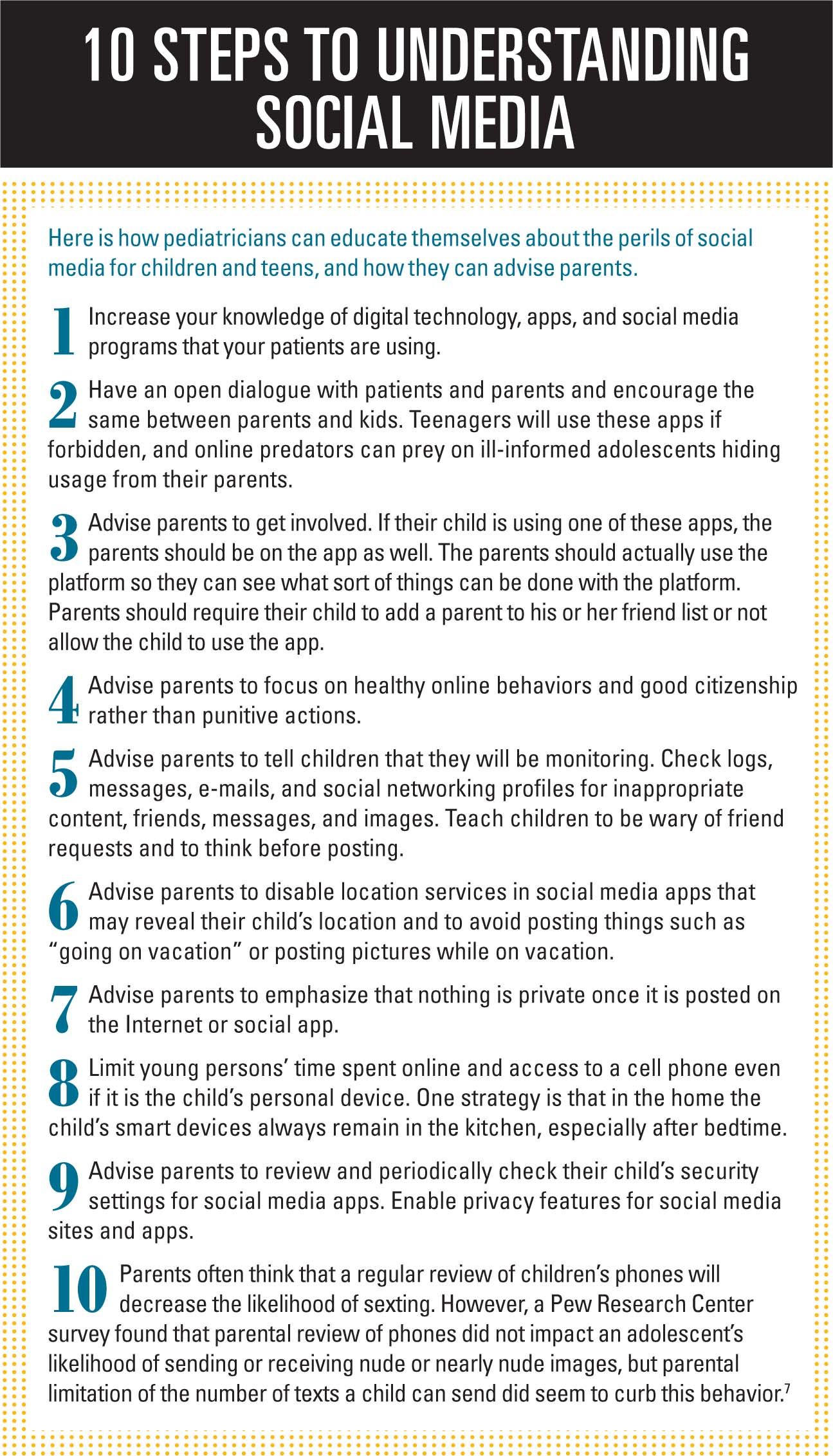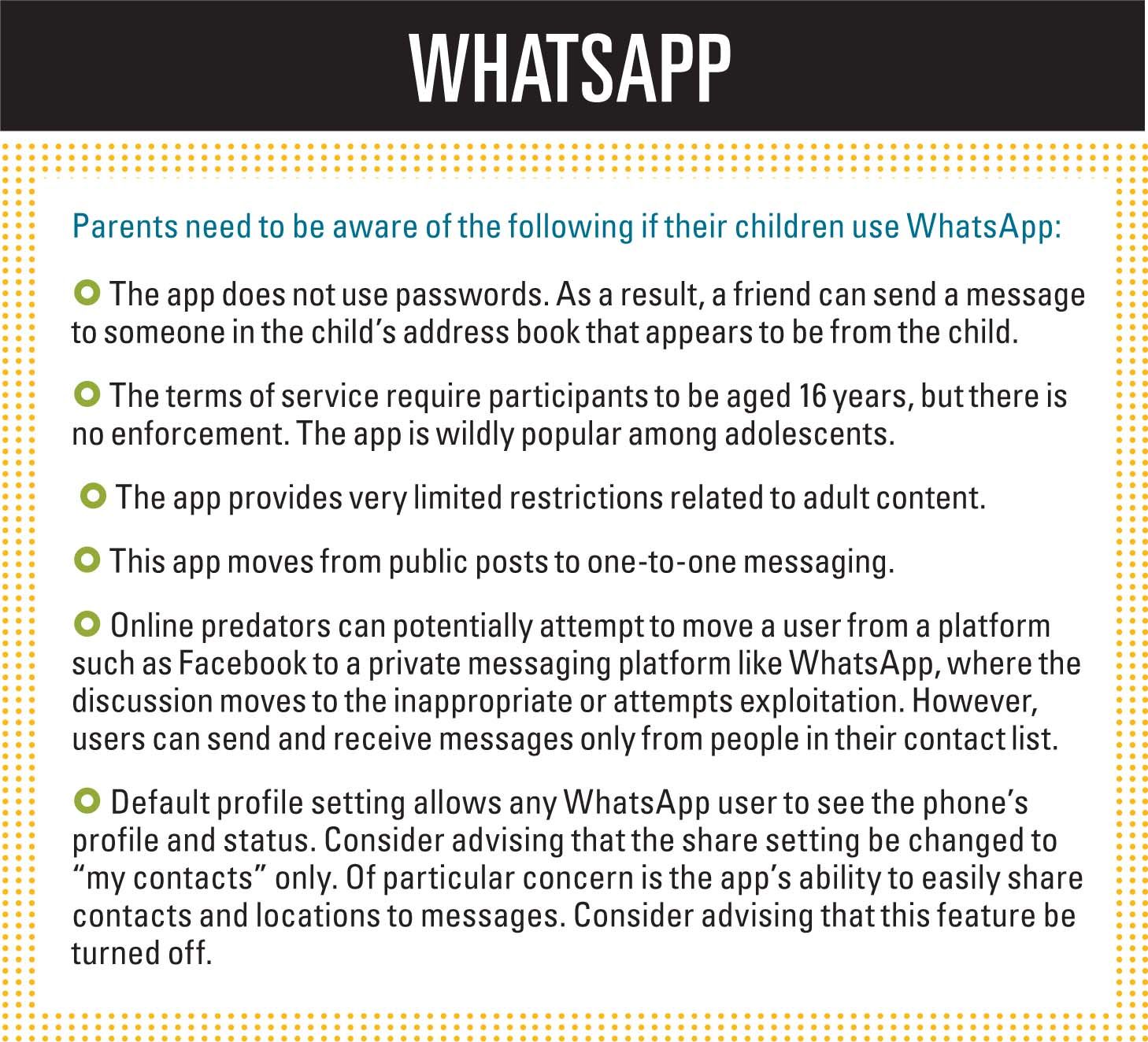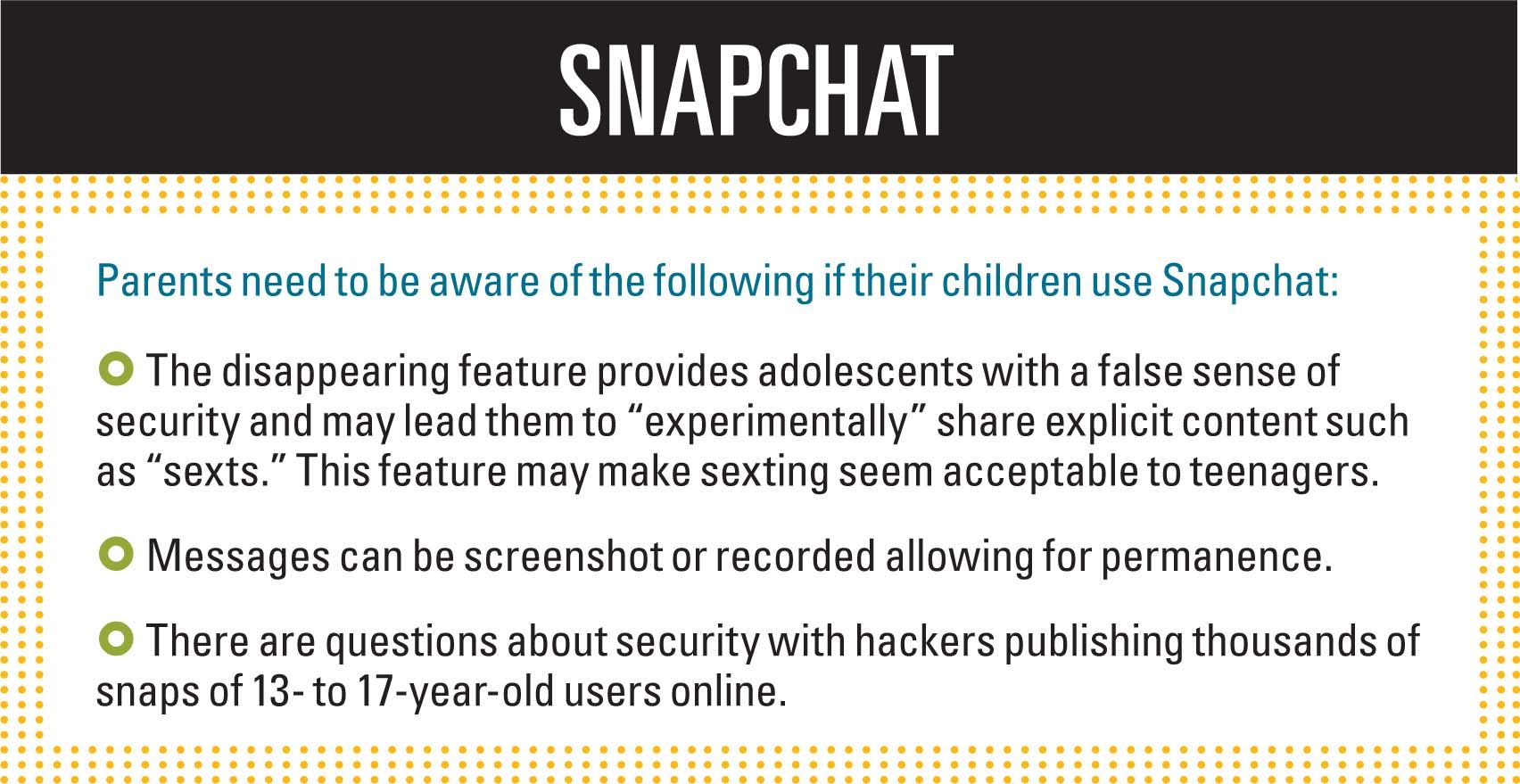Living life online: Talking to parents about social media
Social media applications and surfing the Internet are among the most common activities today for children and adolescents. Although there are a number of benefits of social media, there are also a number of risks.
Social media applications and surfing the Internet are among the most common activities today for children and adolescents. Although there are a number of benefits of social media, there are also a number of risks. Pediatricians should be aware of what children are doing related to social media and its many different opportunities so that they can help parents understand their child’s online activities and provide advice for prevention and monitoring.
What kids are doing online
Whereas parents and pediatricians may have different ways of defining online activities, children and teenagers are doing many different things in an increasingly online world, including:1
· Texting (87%);
· Visiting social network sites (83%);
· E-mail (77%);
· Instant messaging (63%);
· Video chatting (59%);
· Chatting in online games (45%);
· Visiting virtual worlds (35%);
· Writing on a blog (28%); and
· Using Twitter (27%).
Facebook dominates the social networking space with 68% of teenagers saying it is their main social networking site. One in 4 adolescents can be described as a heavy social media user by the definition of using 2 different types of social media daily.1
Recommended: The impact of social media on teen mental health
There appears to be a discrepancy between what teenagers are doing online and what parents believe to be their actual activities. Nearly one-quarter of adolescents log onto social media more than 10 times per day, but only 4% of parents thought their children were logging on so often.2 Similarly, more than half of these young persons log onto social media sites more than once per day and only 23% of parents thought this to be the case.

Potentially more concerning to the pediatrician is what teenagers said they had done online:2
· 28% shared information they would not share in other places.
· 25% shared information using a false identity.
· 39% shared something they regretted later.
· 26% pretended to be someone else.
On a more positive note, 54% joined a group or campaign in support of a cause important to them and 34% had used social media to volunteer for a not-for-profit organization.2
Fifteen percent of 8- to 12-year-olds uses social media daily (9% of boys and 22% of girls) despite apps such as Facebook having a minimum age of 13 years.3 By the teenaged years, 58% of adolescents are daily users, spending an average of more than 2 hours per day on social media sites. By far the most common way that teenagers access social media is with smartphones (63% smartphones, 18% computers, 11% tablets, 8% iPod touch).
NEXT: Risks of social media
Risks of social media
The risks to young persons from social media are probably greater than parents realize. These risks range from being influenced and targeted by advertisers because of digital footprints to online predators and more.
More: Body image and disordered eating
Cyberbullying
This peer-to-peer risk is the deliberate use of digital media to communicate false, embarrassing, or hostile information about another individual. Cyberbullying may take several different forms, including:4
· Harassing messages via text, instant messaging, or other forms of social media use;
· Posting of disparaging comments, lies, or rumors about another person;
· Posting or sharing humiliating pictures without consent;
· Intimidation via electronic means; and
· Pretending to be someone else in order to trick someone into revealing information.
Teenagers report that cyberbullying is to be expected and accepted despite its negative impact. This is made worse by the disinhibition effect or a lack of accountability among perpetrators because they do not see or understand the consequences of their bullying.4 Of particular concern to parents and the pediatrician is the unlimited audience that may see the results of cyberbullying and the potential for the permanent preservation of the words, pictures, or other media used in cyberbullying.
Sexting
The rapid distribution of sexually explicit images and messages via social media has very real consequences for young persons, and the implications may not be fully understood. More than 20% of teenagers report posting nude or seminude photos or videos of themselves.5 In some cases this has led to the potential for felony child pornography charges in some jurisdictions or juvenile misdemeanors in others. School systems increasingly dispense punishments such as suspensions. Victims of unwanted disclosure of “sexts” report significant mental distress, whereas “sexting“ between couples or among small peer groups does not lead to similar mental health issues.
Facebook depression
This term was coined after researchers began noticing classic symptoms of depression after significant time was spent on social media activities.5,6 The depression may result from seeing updates, posts, or photos that make children and teenagers feel unpopular. Such experiences can be intense and place adolescents at risk for social isolation or risky behaviors in a manner similar to offline depression.5
Digital footprint
Many young persons fail to recognize the potential permanency of posting their comments, videos, and pictures on social media sites.5 Furthermore, they do not understand the potential damage to their reputations and the potential implications related to desired schooling or employment. Digital footprints also allow for targeting and identification of advertising and other commercial uses that may take advantage of this age group.
NEXT: Benefits of social media
Benefits of social media
Despite all these risks, there are potential benefits of social media participation for children and adolescents.
Socialization
Social media offers young persons opportunities for growth, including:5
· Volunteer and charity work;
· Sharing creative endeavors such as music and art to a wider audience;
· Growth of ideas through the development of blogs or podcasts;
· Connecting to diverse communities; and
· Promoting individual identity and social skills.
Children and adolescents report that social media use positively impacts their emotional well-being. They more commonly report that social media decreases shyness and makes them more confident, more popular, and more outgoing rather than vice versa.1 Teenagers also feel that social media improves their relationships with friends, including staying more in touch, getting to know other students at school better, and connecting with others sharing a common interest.
More: The latest preventive care visit guidelines
Enhanced educational opportunities
Although enhanced educational opportunities are suggested as a benefit of social media, only 1% of children and 6% of teenagers report using social media for homework benefit.3 About half of both groups feel social media use does not make a difference in the quality of their studying, and nearly one-third believe it has a negative impact. Benefits may include the ability to connect for homework help or group projects.5

NEXT: Specific social media channels
Specific social media channels
Facebook is the most popular social media platform today, but there also are many platforms and apps of which parents may not be aware. Several of these will be discussed here, as well as things the pediatrician and parents need to be aware of when considering if a platform is appropriate for their child.
Recommended: What's new in "connected" medical devices
Messaging apps
WhatsApp, Kik Messenger, and Snapchat are the 3 most common messaging apps in use today among children and adolescents. Other apps that parents may encounter include Omegle, Tinder, Skout, and MeetMe, all of which have similar features. These apps all allow users to send text, video, audio messages, or photos with individuals or groups using Wi-Fi instead of traditional short-message service (SMS). They are popular because they do not use data plans and are less trackable by parents.
WhatsApp lets users send text messages, audios, videos, and photos to 1 or many people with no message limits or fees, making it popular among adolescents whose parents limit their texting. The app automatically connects to people in a smartphone’s address book and encourages them to sign up. Many teenagers like it because most adults do not use it, it is ad free, and the texts do not show up on the phone bill because it’s an app.

Kik Messenger is another texting app that allows free texting with no message limits. It does not require a working phone number.

NEXT: Temporary apps
Temporary apps
Snapchat is one of the most popular apps in this category, but parents may discover others such as LINE and Burn Note. All allow messages to be sent and have some sort of self-destruction promise that more often that not allows for a digital footprint to be permanent.
Next: Gaming addiction in kids and teens
Snapchat has been identified as the number-one favorite app for teenagers. The feature that supposedly allows “snaps” to disappear after a period of time, however, is a myth, and something on Snapchat can end up online forever.

Microblogging
Instagram is a common app in this category. Others include Twitter, Whisper, and Yik Yak. Teenagers like Instagram because they can create a digital diary without advertising content on Facebook. In a popularity-like contest, adolescents compete and get validation from getting more “likes” on their posts. As with all social media, there is increased risk when a teenager overshares.

Video sharing
Vine is a video-sharing app that allows users to create unique, 6-second looped videos. Once the videos are created, they often are shared via Twitter or Facebook, but it is also possible to follow users. Videos frequently have inappropriate or explicit content. As with other apps, the minimum age is 17 years, but this is loosely enforced. Unlike other apps discussed thus far, there also seems to be a risk of peer pressure. For example, searching Google for #firechallenge reveals numerous adolescents lighting themselves on fire. As these videos become popular, more and more adolescents seem to participate in the activity in an “ice bucket challenge”-gone-bad scenario.
YouNow is an app that allows live streaming of video. This is a safety concern because young persons can easily and accidentally share personal information. As with the Vine app, there are concerns with YouNow about adolescents doing things that they normally would not do to obtain “likes” and public approval. Facebook and Periscope also have video-sharing capabilities.
REFERENCES
1. Common Sense Media. Social media, social life: How teens view their digital lives. Available at: https://www.commonsensemedia.org/research/social-media-social-life-how-teens-view-their-digital-lives. Published June 26, 2012. Accessed April 6, 2016.
2. Common Sense Media. Is social networking changing childhood? Available at: https://www.commonsensemedia.org/about-us/news/press-releases/is-social-networking-changing-childhood. Published August 10, 2009. Accessed April 6, 2016.
3. Common Sense Media. The Common Sense census: Media use by tweens and teens. Available at: https://www.commonsensemedia.org/research/the-common-sense-census-media-use-by-tweens-and-teens. Published November 12, 2015. Accessed April 6, 2016.
4. Nixon CL. Current perspectives: the impact of cyberbullying on adolescent health. Adolesc Health Med Ther. 2014;5:143-158.
5. O'Keeffe GS, Clarke-Pearson K, Council on Communications and Media. The impact of social media on children, adolescents, and families. Pediatrics. 2011;127(4):800-804.
6. Steers M-LN, Wickham RE, Acitelli LK. Seeing everyone else's highlight reels: how Facebook usage is linked to depressive symptoms. J Soc Clin Psychology. 2014;33(8):701-731.
7. Pew Internet and American Life Project, Pew Research Center. Teens and sexting. Available at: http://www.pewinternet.org/files/old-media//Files/Reports/2009/PIP_Teens_and_Sexting.pdf. Published December 15, 2009. Accessed April 6, 2016.
Dr Bass is chief medical information officer and associate professor of medicine and of pediatrics, Louisiana State University Health Sciences Center–Shreveport. The author has nothing to disclose in regard to affiliations with or financial interests in any organizations that may have an interest in any part of this article.
2 Commerce Drive
Cranbury, NJ 08512
All rights reserved.